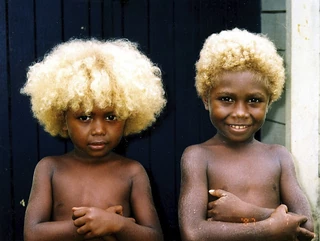Being born with naturally blonde hair is an unusual trait. Two percent of the population is affected, and even then, they are concentrated in Europe, Central Asia, and North America. Blond hair is a trait unique to children, and as kids get older, the natural pigment eumelanin, which controls hair color, increases, and their hair becomes noticeably darker. In this article, we’ll be talking about Melanesians, the world’s rarest blond-haired population. The fact that they have naturally blond hair despite having dark skin sets them apart.
In 1832, Jules Dumont d’Urville first used the term “Melanesia” to refer to a cultural and geographical group of islands separate from Polynesia and Micronesia.
As with the Asmat tribe, the native Melanesians have a dark and violent history that includes cannibalism, headhunting, kidnapping, and slavery. As a result of interactions with Europeans, the majority of the population now identifies as Christian.
As an example, think about the Melanesians of the Solomon Islands. Their location in the South Pacific between Papua New Guinea and Vanuatu places them smack dab in the middle of the Melanesia continent, not far from Australia’s northeastern coast. It is also a sovereign nation and member of the Commonwealth of Nations. Although the indigenous Melanesian population of the islands has the darkest skin outside of Africa, between 5 and 10 percent of them have bright natural blond hair.
Many hypotheses have been put forth to explain these people’s blond hair, including sun and salt whitening, a high fish diet, and genetic heritage from the islands’ founding American and European mestizo populations. Canadian geneticist Sean Myles from the Nova Scotia Agricultural College analyzed the DNA of saliva and hair samples from 1,209 residents of the Melanesian Solomon Islands. By comparing 43 blond and 42 brown Islanders, he discovered that the blondes had two copies of a mutant gene found in 26% of the island’s population. Different from the blond hair genes found in Caucasians, the TYRP1 gene is found exclusively in the Melanesian population, which may help explain why these people have blond hair and melanin.
Because it’s caused by a recessive gene, it manifests itself more frequently in kids than grownups. As a general rule, hair color tends to darken with age. All other races can be traced back to the black Africans, proving that they were the original Homo sapiens.
